Rejection of Donald Trump sweeps across the United States: “We say no to fascism!”
Tens of thousands of people take to the streets across the country in the “No Kings” protests against the president’s policies and in support of the immigrant community
As if waking up from a bad dream that had lasted all week, the city of Los Angeles woke up under cloudy skies at 9.30 am, when the big protest against President Donald Trump and his conservative—or fascist, as many of the marchers’ signs read—policies, began. This Saturday was the day of the big “No Kings” protests, which brought together citizens in more than a thousand cities across the country. People of all ages, faiths (there were priests in clerical collars and women in hijabs), physical conditions, races, and nationalities took to the streets of several cities and towns to raise their voices in defense of migrants and against the ultra-conservative policies of the Republican president, who turned 79 on Saturday and celebrated with a grand military parade in the capital, Washington, D.C.
The rejection of the president’s grandiloquent gesture —even more shocking in a country with 249 years of democratic and civic history behind it— has brought people out onto the streets, from the capital itself to New York, Miami, Chicago, Houston, and Los Angeles, where the protests have been immense. The Los Angeles Times reported around 30,000 attendees, but it seemed like many more gathered at City Hall, the nearby Gloria Molina Park, and the surrounding streets.
The city was in the spotlight on Saturday following protests that have been ongoing since Friday, June 6, when hundreds of demonstrators began marching day after day in the city’s downtown area in response to a large raid that left 50 people detained. Since then, the standoff between the highly democratic city and state and the federal government has escalated. Trump sent up to 2,000 National Guard troops without the approval of the governor or the mayor, who imposed a nighttime curfew in the city center to prevent disturbances.
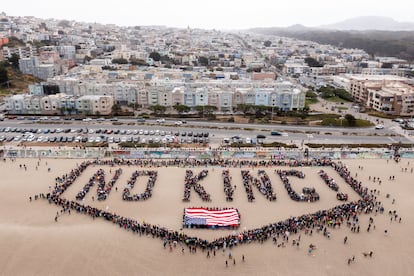
However, this Saturday, the riots seemed to be a thing of the past in downtown Los Angeles, at least during the early hours of the day. There were marches throughout the city and county, from Hollywood to Santa Monica, but the one in downtown was the main one. Even the subway, usually running at half speed in a car-loving city, was full. In the first hour, leaders of civil and migrant rights associations spoke of “the real problems of ordinary people in accessing healthcare and education, of marginalized families, when this land has enough for everyone.”
After the speeches, the march began. In Los Angeles, it was peaceful and calm, with little law enforcement presence, except at the doors of official buildings. It was not until after 4 pm that the police gave the order to disperse and fired tear gas. But before that, the atmosphere was calm. Eighty-something couples carrying signs, families with young children, groups of friends, and activist groups marched down Broadway, through Grand Central Market, and Pershing Square, shouting “We say no to fascism!”, “Fuck Trump,” “Chinga la migra” (Fuck immigration), and calling for ICE (Immigration and Customs Enforcement) to leave the city.
Under the nearly 86°F June heat in Los Angeles, the protesters showed off their creativity on their signs, from those criticizing ICE, to “No kings, only drag queens” or those that branded Donald Trump a fascist, rapist, egomaniac, traitor, or convict, among other niceties. Lily Martinez, 48, the daughter of Mexican immigrants, carried one that read “Immigrants are the heartbeat of Los Angeles.” Dressed and made up like a catrina, with an American flag on her arm, she said it was essential for her to be there. “I am Mexican and Angelina. This is my culture, my pride, I am Mexican, American, Angelina, and immigrants are the heart of Los Angeles,” she said. “I am a citizen, but I am afraid. Because I have children who go to school, to work, they are dark-skinned, they are Latino, and they could be kidnapped. My sister was not deported, but she was detained by ICE when she was dropping her daughter off at school. Thank God they let her go, but she was very scared.”
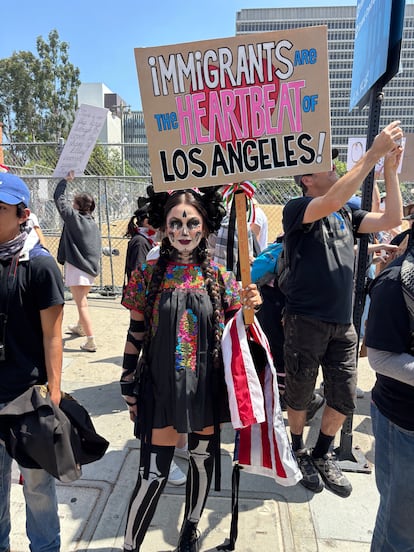
On the other coast, all eyes were on Washington. To ignore the military parade and divert attention away from the capital, the No Kings platform excluded the District of Columbia from the protests organized across the country, but other groups called their own demonstrations. The Refuse Fascism organization chose Logan Circle to start a march that wound through part of downtown Washington and ended at the White House. Hundreds of people participated in the mobilization, which proceeded peacefully until the fences protecting the perimeter of the White House stopped them.
Justin Tobey, a 30-year-old California lawyer living in DC, carried a banner reading “Fags against fascism.” “I am proudly gay, and I don’t know any gay people who support this,” he said, referring to the military parade. The threats made by the president in anticipation of protests on the same day encouraged him to participate. “Trump said that if people protest, they will respond with force, and I don’t want to give in to that kind of threat, so here I am.” After seeing the violence used to suppress protests in Los Angeles this week, he admitted he was “a little scared.” “But I would feel worse if I didn’t come,” he said.
Born in California, he said he had never seen anything like this week’s deployment of the National Guard and Marines, which he considers “completely disproportionate and horrible.” On the recent raids in California fields against farmworkers, Tobey said, “I see the videos of ICE chasing immigrants through the strawberry fields around my hometown. It’s really scary and outrageous.”
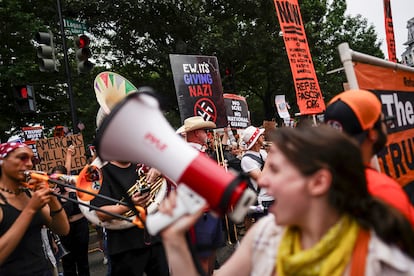
Jess (who prefers not to give her last name) is 19 years old and a medical student in Maryland. She attended the march in D.C. “to protest against Trump, who is forcibly and illegally kidnapping people and making immigrants who pay taxes, work for this country, and don’t deserve to be separated from their families disappear.” Like the hundreds of people who participated in the march, she is very critical of the military parade organized by Trump. “I find it very disturbing to have military personnel in Washington, D.C. in this way. I’ve lived in the area my whole life and it’s scary. It’s authoritarian.”
The parallels between the Trump administration and dictatorial regimes were featured on many of the protesters’ banners. Images of Trump with a Hitler-style mustache, with the characteristic haircut of North Korean leader Kim Jong Un, or kissing Russian President Vladimir Putin on the mouth were visible among the crowd.
Barbara Taushanoff came from Cleveland, Ohio, to participate in the march. At 69, she felt it was necessary because “leaving Trump in the presidency is dangerous.” In her opinion, impeachment is necessary to remove the Republican from the White House. She saw the deployment of the National Guard in Los Angeles as a sign of this administration’s authoritarianism and criticized the selection of Trump’s cabinet members, whom she considers incompetent: “The government is for sale under his command. That is also related to authoritarianism.”
Among the protesters who crossed the country were angry people, but also people happy to finally take to the streets in a feeling of collective rejection after four months of Trump’s heavy-handedness. “I feel very angry about what is happening to my friends, to immigrants, it’s horrible,” says Ida María, 22, a resident of Saint Louis but visiting Columbia, Missouri. She carries a sign with a large butterfly and the phrase “Migration is natural,” with which she wants to ask people to be a little more humane. “Sometimes I don’t know what to do, but going to protests is a way of saying that I don’t feel good about this.”
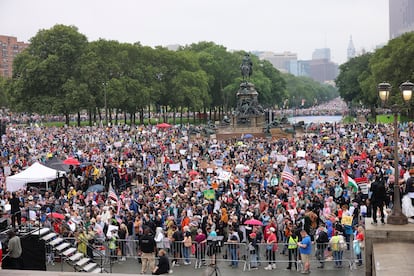
Melissa Cantú, 31, a resident of Columbia from a Mexican family, is also feeling uneasy. Together with her young son, she holds up a sign that reads, “You see migrants, but I see my family.” “This is personal. What my son sees is a family. I was born here, but to everyone else, I’m Mexican,“ she says. ”We all have an uncle, a mother, a grandmother who emigrated. I’m here for all of them.”
Even in South Florida, hundreds of people participated in protests in downtown Miami, Miami Beach, and Fort Lauderdale despite threats from state authorities to discourage the marches. Protesters held up banners with messages such as “When tyranny becomes law, rebellion is a duty,” “Americans bow to no king,” and “Stop inhumane detentions and deportations,” while chanting slogans.
“It’s very important for the country to see that we’re not happy with what’s going on. We have checks and balances in the United States, the executive branch is overstepping its bounds, and I don’t like that,” said Kitty Pierce, a tourist from Seattle who joined the protest on the Fort Lauderdale boardwalk.
“I want the world to know that there are people in the United States who oppose the tyranny that Trump wants to impose,” said a protester who identified himself as Javier in downtown Miami, who came to condemn the detention of undocumented immigrants. “We are a country of immigrants; we were founded by immigrants. If you are an immigrant and you can’t come (to the protest) because you are afraid, you are not alone, people like me are with you.”
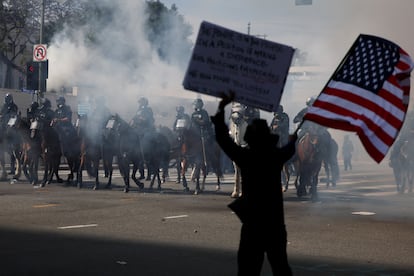
With information from Maye Primera and Jesús Jank Curbelo
Tu suscripción se está usando en otro dispositivo
¿Quieres añadir otro usuario a tu suscripción?
Si continúas leyendo en este dispositivo, no se podrá leer en el otro.
FlechaTu suscripción se está usando en otro dispositivo y solo puedes acceder a EL PAÍS desde un dispositivo a la vez.
Si quieres compartir tu cuenta, cambia tu suscripción a la modalidad Premium, así podrás añadir otro usuario. Cada uno accederá con su propia cuenta de email, lo que os permitirá personalizar vuestra experiencia en EL PAÍS.
¿Tienes una suscripción de empresa? Accede aquí para contratar más cuentas.
En el caso de no saber quién está usando tu cuenta, te recomendamos cambiar tu contraseña aquí.
Si decides continuar compartiendo tu cuenta, este mensaje se mostrará en tu dispositivo y en el de la otra persona que está usando tu cuenta de forma indefinida, afectando a tu experiencia de lectura. Puedes consultar aquí los términos y condiciones de la suscripción digital.
More information

Immigration raids disrupt businesses and migrant families in Los Angeles: ‘I haven’t seen it like this since Covid’
Archived In
Últimas noticias
Maduro pleads not guilty before the federal court in New York: ‘I am still the president of Venezuela’
A new test can detect Alzheimer’s from a finger prick
UN team enters Sudanese city of El Fasher after paramilitary massacre: ‘It’s like a ghost town’
A recipe for resistance: Indigenous peoples politicize their struggles from the kitchen
Most viewed
- Gilles Lipovetsky: ‘If you want to live better and fall in love, take Prozac, don’t look to philosophy’
- Alain Aspect, Nobel laureate in physics: ‘Einstein was so smart that he would have had to recognize quantum entanglement’
- Alvin Hellerstein, a 92-year-old judge appointed by Bill Clinton, to preside over Maduro’s trial in New York
- Why oil has been at the center of Venezuela-US conflicts for decades
- Maduro’s downfall puts China’s relationship with Venezuela to the test









































